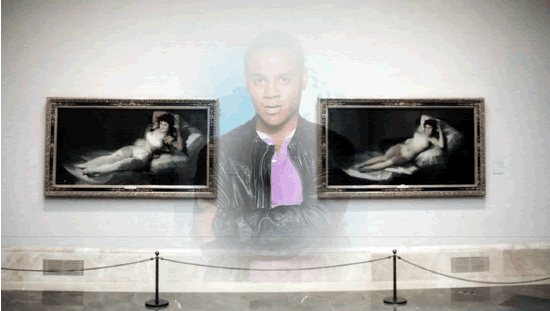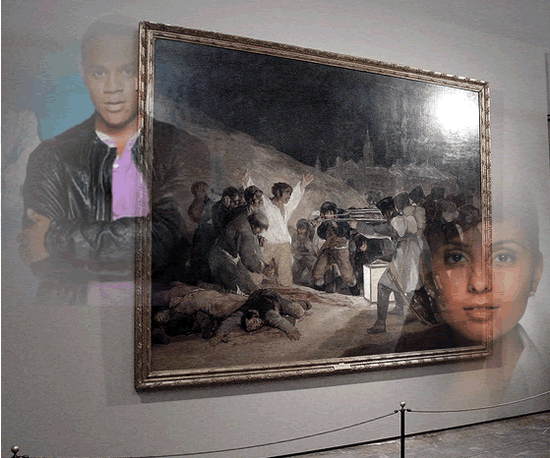

“I like the lifestyle your newspaper’s expense account allows us to live,” Clyde Langer said as he stepped into Rani’s hotel room through the connecting door from his own room. “Do you know this place has a swimming pool, Turkish bath and spa, full on cardio gym, the works.”
“Have you had the works?” Rani asked. She was sitting at the window looking out at the street below. It was only the end of March, so the trees weren’t fully in leaf. She could see through them to the building opposite the modern boutique hotel where they were staying. Bright late afternoon sunshine warmed the cream coloured stone of the eighteenth-century Neo-Classical edifice of the Museo del Prado.
“There isn’t time this evening,” Clyde admitted. “But the pool and spa opens at five-thirty. I thought I might get up early tomorrow….”
Rani laughed.
“Clyde, you have never got up early in your life. That’s why dad was always on your back about punctuality.”
“I can get up early if I have a better reason to get up than double maths,” Clyde pointed out. “I don’t mind getting up to go to college, and I’ll definitely get up for a swim, gym and Turkish bath.”
“You might not make it,” Rani told him. “The reception after the press preview could go on until quite late. These things very often do.”
“You sound as if you’ve been assistant culture editor at the Guardian for years. You only got the post at Christmas.”
“I know.” Rani smiled proudly. Of course, the reason they gave her the promotion had nothing to do with her talent as a journalist. It was because the last three stories she had submitted never got published - they had been blocked by the Ministry of Defence for coming too close to revealing the existence of alien life on planet Earth. She had started to worry about losing her job altogether before the new head of U.N.I.T., Professor Kate Stewart, talked to her editor and he decided to shift her from science and technology to arts and culture, where she was less likely to run into issues of national security.
Well, at least there shouldn’t be any aliens at the Prado. She was looking forward to the press preview immensely. It was a chance to write an in depth piece on the art story that had rocked Europe.
Clyde was excited, too. As an aspiring artist himself it was almost too incredible to be here, with only four lanes of traffic and a tree and sculpture lined embankment between him and one of the most famous art museums in the world.
Of course, the Prado was all about pre-nineteenth century art, Old Masters, religious icons, dark, heavy portraits and landscapes under centuries-old varnish. Clyde’s personal preference was for ‘modern’ art – in other words, everything NOT found in the Prado. But art was art, and there were some famous works from those Old Masters that he really wanted to see up close.
“You look smart,” Rani told him. Clyde was not really a suit wearer most of the time, and this one was hired for the occasion, but it looked good on him.
“You look fantastic,” he replied. He felt a little out of his comfort zone, but if he was going to accompany Rani, dressed as she was in a pale blue silk cocktail dress and cashmere shawl with shoes and accessories to match, then he couldn’t tag along in jeans and sweatshirt and a pair of trainers.
And he WANTED to accompany her on occasions like this. It was worth getting dressed up to look like he belonged with her.
“Shall we go, then?” she suggested. He reached out and took her hand as they headed downstairs.
“Signorina Chandra,” the receptionist called out when they reached the hotel foyer. “There is a package for you. It was delivered by hand, and marked ‘urgent’.”
“A package for me?” Rani was puzzled. She already had the press pack she needed for the evening. She was even more puzzled when she examined the brown jiffy bag. It felt like a pen inside. Why would anyone send her a pen?
She opened it and pulled out what looked exactly like a pen – a good quality pen that exclusive shops sold in engraved presentation boxes - but still just a pen.
There was a note with it.
“I heard on the grapevine – i.e. from Sarah Jane - that you’re attending the Goya presentation at the Prada. I’m curious about whether the painting is real. I don’t remember the old chap doing a third picture in the series. Use the pen to check it out. Just click and point.
Signed
The Doctor.”
“Wow!” Clyde exclaimed. “Even he thinks it might be dodgy!”
“So it seems.” Rani turned the pen over in her hands then aimed it at a framed painting on the foyer wall. She expected it to light up or beep in some way. Instead words formed in the air in front of the painting confirming that it was a ‘reproduction’. Well, obviously. The original of Las Meninas by Diego Velázquez was one of the most famous paintings in the museum across the road.
“Did anyone else see that?” Clyde asked as the words dissolved. He looked around at the receptionist and the waiter bringing coffee to a couple sitting in the lounge area, but none of them had been staring at magical words that had written themselves in thin air.
“It must be one of those things that come from being in The Doctor’s TARDIS – like understanding different languages. Anyway, it could be useful. After all, a lot of people really do think the ‘new’ Goya is a fake.”
They stepped out of the hotel and crossed the first part of the busy Paseo del Prado, noting with a sense of irony that the name of Spain’s most famous art museum actually meant ‘meadow’.
The wide embankment between the two pairs of traffic lanes might be quiet very early in the morning, but the rest of the day the trees, sculptures and fountains were almost outnumbered by people. It was a VERY long time since there had been anything like a meadow here.
It was a little quieter on the other side of the Paseo. The Prado was closed to the public now and there were not so many people in the gardens around the building. The Velázquez portico – so named for the statue of the artist that stood before it - was guarded heavily by men in dark uniforms and their invitations were checked thoroughly before they were allowed to make their way towards the equally well guarded exhibition hall in the east wing of the Villaneuva building.
In daylight the octagonal hall with a high glass roof was bright with natural sunlight, but it was after sunset now and soft yellow light from the electrified chandeliers filled the central area while the paintings were carefully lit individually by specially designed artificial light that wouldn’t affect the centuries old paint.
“The Prado has a hundred and forty paintings by Goya,” Rani said, reciting the information she had memorised from the press pack. “Francisco José de Goya y Lucientes as he is properly known.”
“Spanish people take one surname from their father and the other from their mother,” Clyde told her. “His father was Goya y Franque and his mother was Lucientes y Salvador.” He remembered that from the history of art course he had been doing for the past year.
“This room has twenty of his most famous works on display. The rest are in four other rooms in this wing of the museum,” Rani added. She stopped in front of a very big canvas – the plaque beside it said it was two hundred and sixty six centimetres by three hundred and forty-five centimetres. She recognised the image immediately but the scale of it in real life was startling.
“May 3rd 1808,” Clyde confirmed with a knowledgeable nod of the head. “French soldiers shooting down unarmed Spanish men in retaliation for an uprising against them. To the left, is May 2nd, 1808, a painting of the uprising itself.”
“It’s a sad subject, yet strangely compelling,” Rani admitted. “The men pleading for their lives, hands up in surrender, covering their faces in terror, and the line of soldiers who won’t listen to any plea, show any mercy….”
Clyde suppressed a giggle. Rani looked at him in disgust and some surprise. She thought he had grown out of the class clown mentality of his school years.
“Sorry,” he told her. “But I was just thinking of a lecture we had about this painting and the art of pastiche and parody.” He went on to describe the slide show of different images based on Goya’s work. Picasso’s world famous Guernica and Édouard Manet's Execution of the Emperor Maximilian were memorable examples of how war, right up to the present day, had been depicted in art using Goya’s work as inspiration. But he also remembered the laughter that pealed around the room when they were also shown a slide depicting a goalkeeper with his hands raised to defend the goal against the oncoming team - done in the style of Goya’s painting. There was even more laughter when they saw a version of the painting done with Lego figures. Such was the iconic status of the work they stood before now.
Rani’s mouth turned up at the edges as she tried to imagine the painting done in Lego. She forgave him for his irreverence before such a masterpiece and let him hold her arm as they moved through the galleries admiring more of Goya’s works. He was a painter who went through many phases in his life and career. The brighter works like El Quitasol – featuring a pretty girl in a colourful dress sitting under a parasol in the sunshine with a contented dog asleep on her lap - came from a brighter period. In total contrast were las pinturas negras – the black paintings – with subjects like a witches Sabbath and the gory Saturn Devouring His Son which they were both happy to pass on from when they were called to the end gallery where the presentation was taking place.
Working for one of Britain’s most well-regarded newspapers ensured seats in the second row of those set out in the gallery space that was usually left open for the public to wander freely among the art. The cream of the Spanish media had the front row. A photographer from Rani’s paper, a man she knew by the name of Ray, sat with them ready to get a shot when the picture behind the curtain was revealed.
Either side of the velvet curtain were two paintings any student of Goya’s works would recognise immediately. Clyde had seen prints of them many times, but as with May 3rd 1808, the scale of the actual paintings was surprising. Nothing quite compared with the real thing.
“Oi,” Rani whispered to him. “Look at the one on the left. Never mind THAT one.”
Clyde grinned. On the right was Goya’s famous study of the female form, La Maja Desnuda. On the left was the equally famous but more pg-rated La Maja Vestida. They were two paintings of the same woman in the same position, prostrate upon a bed with her arms raised around her head. The difference between the two was quite obvious.
“I’m in art college,” Clyde reminded his girlfriend. “We’ve done life study more than once. I’ve painted Human bodies clothed and unclothed.”
“I don’t care. You can look at the CLOTHED version when you’re with me,” she responded.
Clyde shrugged and concentrated his attention on La Maja Vestida.
“Did you know that Goya was summoned before the Inquisition about that painting?” he said.
“What Inquisition?” Rani asked.
“We’re in Spain,” Clyde pointed out. “What Inquisition do you think?”
“The Spanish Inquisition,” said Ray, the photographer. “You know, ‘Nobody expects the Spanish Inquisition!’”
The three of them laughed softly at a joke only they, the British contingent, could completely enjoy.
“Why would the Spanish Inquisition want to question Goya about a painting of a woman?” Rani asked.
“They wanted to know who the woman was,” Clyde answered. “But he wouldn’t tell them.” Rani began to query that, but Clyde didn’t have any answers. “Nobody really knows all these hundreds of years later. Maybe she looked like the Queen of Spain or the High Inquisitor’s sister or something. Anyway, they insisted he paint over the nude body. Instead he did another painting with clothes on and left the original alone. I don’t know why they made such a fuss, though. There were loads of nude paintings before that time and since. It’s… you know… art.”
“You can still look at the clothed one,” Rani insisted. “And you,” she added to Ray. Both men got ready with ripostes but the curator of the Goya collection was taking his place on the podium beside the covered painting. Everyone got ready to hear what he had to say.
Of course, he spoke in Spanish, but Clyde and Rani heard him in English. They had travelled in The Doctor’s TARDIS more than once and as Rani had mentioned earlier, understanding any language, written or spoken, was one of the lasting privileges that went with that sublime honour.
They had no problem listening to the curator explain how the unknown Goya had been discovered in the long forgotten cellar of a house in Manzanares el Real, not far from where Goya had lived for some time in his later life. The house had belonged to one of his close friends and it was believed that the painting might have been a gift to the friend. The house had been damaged during the Spanish Civil War and partially rebuilt, the cellar entrance being covered up in the process. Only last year when the derelict and empty house was being restored to its former glory, was the cellar and the national treasure within discovered. It had been authenticated by experts from all over Europe and as far away as the Metropolitan Museum of Art in New York, which housed the largest collection of Goya paintings outside of Spain.
Even so, there were some who speculated that the painting was a modern fake. When tests on the chemical composition of the paint and varnish confirmed its age, they insisted it was the work of a contemporary who sought to emulate the great man. They pointed to the recent controversy about the painting Colossus, long attributed to Goya and included in the Prado’s collection, but now listed as the work of Asensio Juliá.
But the evidence mounted until it became indisputable, and now, the curator said with a proud flourish, they were here to see, on display for the first time, Goya’s third image of the mysterious dark haired lady - La Maja en Pie.
The curtain was dropped ceremoniously and Ray the photographer was far from the only one to rise from his seat to get the best possible photograph of the moment. La Maja en Pie was a portrait length rather than landscape because the lady was standing with her unmade bed in the background. She was wearing a long silk shift that covered her body while clinging to it in ways that left very little to the imagination. It had obviously given the painter great joy creating the curves and lines, the highlights and shadows, of a female body without actually doing anything the Inquisition could get upset about.
Clyde kept to his seat and watched as Rani carefully pointed the pen at the painting. Words appeared in the air in front of the new Maja.
“Original, painted by Francisco Goya y Lucientes in 1805,” the words confirmed.
“It’s real,” Clyde whispered.
“Good,” Rani answered. “It would have been a great story if it was a fake, but I don’t know how I could have proved it when all the experts were so certain.”
Then she gasped in astonishment and stared at Clyde.
“What?” he asked.
“Look,” she told him urgently. She had accidentally swung the pen towards La Maja Desnuda. Words appeared in the air in front of it.
“Fake, painted 2013!”
“What?”
Rani swung the pen towards La maja vestida.
“Fake!”
“What?”
“The two Maja are fake,” Rani said. “That’s what the pen is telling us. The new painting is REAL, but the original is fake.”
“But they can’t be,” Clyde argued. “It’s not possible. They’ve been here in the Prado for years. This place has mega-fantastic security and experts all over the place. They’d KNOW.”
“Maybe the pen is calibrated wrongly,” Rani suggested. “Maybe it has fake and real mixed up.”
But she knew in her heart that wasn’t the problem. The two famous paintings were fake.
“What are we going to do?” she whispered. “We have to tell somebody. But how do we explain….”
“We can’t tell anyone,” Clyde answered. “Nobody will believe this.”
The formal presentation was over. The press and photographers were invited to partake of the champagne reception and ask all the informal questions they wanted.
Rani had lots of questions, but they weren’t the sort she could ask in front of all the other reporters. Instead she walked slowly around the galleries pointing the pen at each of the paintings.
She stopped, finally, at the magnificent canvas of May 3rd, 1808. Tears pricked her eyes as the pen confirmed that this, too, was a fake.
“It can’t be,” she whispered hoarsely. “It just can’t be.”
“How?” Clyde asked. “I mean… that many of them…. I counted twenty of the Goyas, and that’s only a fraction of the collection in the whole building. How was it done?”
“It….” Rani tried to think of an answer to the question.
“Hey, you two,” Ray approached, his camera held in uncharacteristically shaking hands. “There’s something really weird going on around here. Some of these paintings aren’t what they seem to be.”
“What do you mean?” Rani asked him.
“I mean… this one… for instance….” He waved his hand towards the beautiful yet terrible depiction of the cruelty of war, then showed Rani and Clyde the digital image of the picture he had just taken of it while the two of them were standing there.
“Bloody hell!” Clyde exclaimed. Rani gasped out loud. They looked at the painting again and then at the digital display on Ray’s very expensive professional camera.
“They say the camera never lies,” Ray pointed out. “But in that case, what’s the matter with our eyes?”
Rani turned away from the digital display of May 3rd 1808 as it would look if the animators of The Simpsons had painted it, with Homer in the middle of the group holding up his hands in defeat.
For a second as her face turned towards the canvas that was exactly what she saw – a nine foot by ten foot painting of modern cartoon characters – before her eyes adjusted and it was normal again.
“It’s not the only one,” Ray pointed out. He scrolled through the images kept on the camera’s digital chip. Rani and Clyde stared at The Milkmaid of Bordeaux done in the style of the exuberant but talentless woman who had famously ruined a fresco in the church of the Santuario de la Misericordia in Borja last year. The fine study of crowds against architecture, Pilgrimage to the Church of San Isidro, 1788, was now a child’s painting of a house with four windows and a door and curling smoke coming out of the chimney into a strip of blue paint sky at the top of the canvas.
Saturn eating his child was possibly easier on the eye as figures made of fuzzy felt shapes, but the desecration of art was still terrible.
As for La Maja - dressed and undressed, they were paper collages featuring a pair of cut out dolls, one with clothes pasted on, the other without.
Clyde looked up from studying those shocking images on the camera display and yelped in horror at the sight of May 3rd 1808 Simpsons style in full canvas. He closed his eyes and hoped it would go away, but it didn’t. It was still there.
“A perception filter,” Rani explained. “The Doctor told us about them. A trick of the mind, our perception of what we see. It’s a way of making things invisible - as long as nobody expects them to be there, but as soon as you know they’re there… then they… are…. They’re… there.”
She felt her explanation had ended rather lamely, but her meaning was clear enough to Clyde and Ray. After all, the evidence was in front of their eyes now that the scales had been lifted.
“This is NOT the only camera in the museum today,” Ray pointed out in a carefully measured voice. Normally any kind of camera, even camera phones that got just about everywhere else, were not permitted. The security guards rigidly enforced the rule.
But the Press had been invited to take photographs this evening, and they had done so.
The party from the Guardian of London looked around at their colleagues from Le Monde, El Pais, Il Messaggaro, Le Figaro, De Tijd, Die Zeit, De Telegraaf, the Irish Independent, Público and Good Housekeeping. None of them had any reason to think that the paintings were anything but what they expected them to be. They hadn’t yet seen through the perception filters.
But, as Ray had observed, cameras couldn’t be fooled. They didn’t have brains that could have their perceptions altered. They saw what was really there. As soon as one of the other photographers looked at what they’d photographed the cat would be out of the bag.
Rani turned slowly and noticed one of the security guards who mingled with the guests. There was something about the way he was behaving, something about his walk, the expression on his face, that made him seem suspicious.
And since she knew there was something suspicious going on, somebody acting suspicious was – well, suspicious.
She still had the pen in her hand and she wasn’t sure whether to be surprised or not when she saw words appearing in the air above the man’s head.
“Follow him,” she told Clyde. “He’s a fake, too.”
The guard was moving urgently but without actually running, towards a door marked ‘Área Restringida - Solo Personal Autorizado’, but the pen suggested that THIS was also a fake so Clyde had no qualms about leading the way. Rani followed him. Ray followed them both. Nobody had told him not to.
“What the blinking flip is this?” the photographer asked. He raised his camera to take a picture of the octagonal metal corridor they found themselves in before changing his mind about drawing attention to their presence by the flash bulb going off.
“I’m going out on a limb here,” Clyde answered him. “But I think this might be an alien space ship.”
“An….” Ray went through scorn, scepticism, doubt and finally acceptance in a few seconds. After all, it had just occurred to him that they had stepped through a door that was on the outside wall of the first floor of the Prado. If there hadn’t been an alien space ship on the other side they would all be lying in the formal garden by the Murillo door with broken limbs and cracked skulls.
“Why?” he asked, instead.
“Intergalactic art theft,” Rani answered. The corridor ended in a wide octagonal room with metal walls, roof and floor with metal neo-classical columns and mouldings. She wondered why it looked familiar at first, then she remembered it was a lot like the central gallery of the Goya exhibition.
Which shouldn’t have been too much of a surprise since the walls were covered in paintings, most of them the missing Goya works, but also some of the other treasures of the Prado including Las Meninas by Diego Velázquez, The Garden of Earthly Delights by Hieronymus Bosch and Caravaggio’s David and Goliath.
“Yes… but… WHY?” Ray asked. “I mean… WHY?”
“Because they’re priceless and unique and somebody is greedy,” Clyde answered.
“Because humans don’t deserve them,” said a voice derisively. The guard stepped in front of them, his face reflecting the tone of his voice. Strangely he still looked like the guard, even though he was no longer using a perception filter and they could see that he had snakelike silvery grey skin and eyes that bulged like a frog. He looked like an alien museum security guard.
“Fine art is wasted on your ridiculous species that values cheap and tawdry rubbish more than the works of great men,” he continued.
“What?” Ray was the first to find a voice. “Who says we value rubbish more than art?”
“Look around your world. Listen to the atonal mess that humans call music, look at the talentless so-called ‘modern’ art, magazines full of inept photography and gossip about the insipid people you call celebrities… illiterate fools calling themselves writers… the cheap rubbish humans buy every day to decorate their homes….”
“There’s nothing wrong with modern art,” Clyde protested.
“Magazine photography is an art form of its own,” Ray pointed out with justified pride in his own career.
“I am far from an illiterate writer,” Rani said at the same time.
“There IS a lot of rubbish in the world,” Clyde admitted. “But there is also a lot of talent, and plenty of people who properly appreciate it. That’s why three million people a year come to the Prado to see the paintings, here.”
“Chattering fools who don’t know what they’re looking at,” the alien guard/art thief responded. “Their minds are on the souvenir shop and going to Macdonalds for a tasteless burger and chips.”
“Well, people get hungry,” Clyde pointed out. “Besides, it’s not as if you’d let them bring take-away into the museum. But that’s beside the point. Even if the whole population of this planet was as thick as two short planks and didn’t know the difference between Van Gogh and Van Halen, those pictures belong in the Prado, so that people can come and find out what they’re missing when they realise that they’re missing it. And they’re not going to miss it because you’ve taken the good stuff and left a load of rubbish instead.”
“Actually, I thought the Simpsons picture was good,” Ray pointed out. “A really clever pastiche. But Clyde’s right. This can’t happen. You put those pictures back where they belong or….”
“Or what?” the guard demanded.
“Or you’ll regret it,” Clyde said. “Ray… flash him.”
“I beg your pardon!” Rani exclaimed. But Ray understood what he meant. He stepped close to the alien and raised his camera. The space ship had no natural daylight, and the artificial lights were mostly concentrated on the paintings. The camera automatically detected the need for a flash.
It went off very close to the silvery grey face. He yelped as his bulging eyes were temporarily blinded, then again as Clyde stuck his leg out and tripped him. He went down hard on the metal floor.
“Nice one, boys,” Rani said as Clyde and Ray tied the alien’s hands behind his back with his own belt and then dragged him to his feet. “But what if he has a whole bunch of his mates with him?”
“He doesn’t,” Clyde answered. “They’d be here by now, the amount of time we’ve been hanging around here, debating the issue with him. I think he’s on his own. Space ships don’t always need crews, after all. He’s like The Doctor, travelling alone, except to steal, not to save people.”
“Is that right?” Rani asked the alien art thief.
“No, he’s wrong. I have an army at my command. You won’t get off this ship alive.”
Rani smiled as she aimed her pen at him and words appeared above his head.
“Liar, deceiver.”
“Good enough for me,” she said. “Any idea how to call the Spanish branch of U.N.I.T.? I don’t think I want to explain all of this to the ordinary police.”
“We’ll call Sarah Jane,” Clyde answered. “She can call the British U.N.I.T. and they can call the Spanish lot. Make sure you negotiate with them for the story about an audacious art theft, replacing the greatest works of the Spanish Old Masters with fakes. Ray’s got the pictures to go with the story. I agree with him. The Simpsons one is pretty good.”

 |
 |
 |